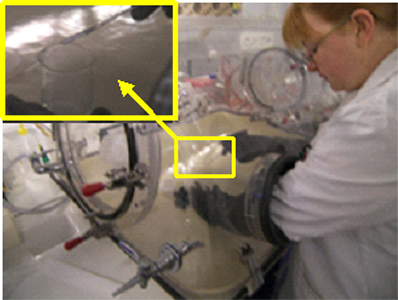
Glovebox powder transfer.
Liquid method: (gloves, lab coat, and chemical glasses) must be worn. If the solvent is organic: handling in a ventilated fume chamber. For small volumes (ml), and when the nature of the solvent allows (ethanol or water, for example), handling is performed outside of the fume chamber, e.g. characterization.
Dry method: the placing in solvent is performed in a glovebox, in the event of a very low quantity of powder in the fume chamber. Decanting to the solvent recipient is then performed in the fuel chamber with a FPP3 mask, avoiding the formation of a powder cloud.
Lab coat, glasses and gloves compulsory for every person working in the premises. The visitors have to wear glasses before penetrating into the premises.


